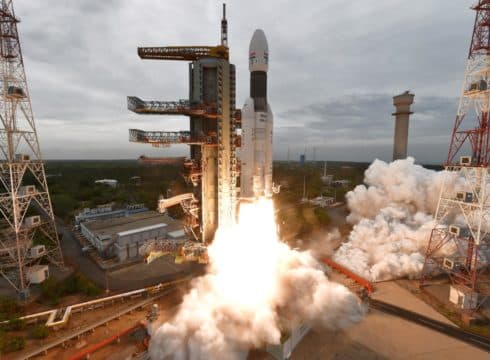The manoeuvre was scheduled to begin at 3:42 AM on September 4 and went as planned
The second de-orbiting manoeuvre brings Vikram Lander to the required orbit to begin its descent journey
The soft-landing is expected to happen between 1 AM and 2 AM IST on September 7
Inc42 Daily Brief
Stay Ahead With Daily News & Analysis on India’s Tech & Startup Economy
India’s moon mission Chandrayaan 2 has successfully completed its second de-orbiting manoeuvre for its Vikram lunar lander, the Indian Space Research Organisation (ISRO) confirmed today morning (Sept 04).
The manoeuvre was slotted to begin at 3:42 AM this morning and went as planned, with the onboard propulsion system coming in to play. The total duration of the manoeuvre was nine seconds, but it is a big step forward for the lander, which is expected to make a soft landing on September 7.
The Vikram Lander’s orbit is 35 km x 101 km at the moment, and while the Chandrayaan 2 Orbiter continues to orbit the Moon further away. The second de-orbiting manoeuvre is crucial as it brings Vikram to the required orbit to begin its descent journey towards the surface of the moon.
The soft-landing is expected to happen between 1 AM and 2 AM IST on September 7, which would then be followed by a touchdown within the next 30 minutes. The current orbit of Vikram Lander is 104 km x 128 km. Chandrayaan 2 orbiter continues to orbit the Moon in the existing orbit and both the Orbiter and Lander are healthy. Prime Minister Narendra Modi will be watching from the space agency’s control room, along with students invited by ISRO for the historic landing.
If the soft landing on the surface is successful, India will become just the fourth country after the US, Russia and China, to successfully make a soft landing on the moon surface. India’s second mission to the moon will study the extent of water molecules on the moon’s surface, evidence of which was discovered by Chandrayaan 1.
India is not the only country focussed on the moon’s southern pole. The NASA, companies such as Elon Musk’s SpaceX and Jeff Bezos’ Blue Origin have been planning to foray to the southern pole of the moon. The Chinese Lunar Exploration Program is also focussed around the southern pole and was launched in 2007. It currently has a robotic rover on the moon.
After the moon landing, ISRO’s Pragyan rover will be separated from the launcher. Pragyan is a six-wheeled robotic vehicle, which can travel up to 500 m and uses solar energy to charge itself. The rover can only communicate with the Vikram Lander.
{{#name}}{{name}}{{/name}}{{^name}}-{{/name}}
{{#description}}{{description}}...{{/description}}{{^description}}-{{/description}}
Note: We at Inc42 take our ethics very seriously. More information about it can be found here.


